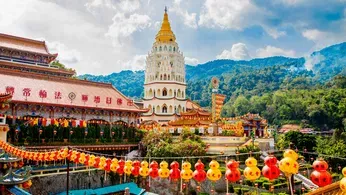
Jul 1
Visiting Penang's Temples and Heritage Sites
READ TIME: 4 MIN.
Penang isn't just about beaches and food; it's a living museum of cultures, stories, and sacred spaces. The island's temples and heritage sites speak volumes about its multiethnic history and devotion to preserving the past.
If you're planning a mindful, experience-rich itinerary, these sites are a must. And with modern tools such as a Penang eSIM, staying connected while exploring these timeless places becomes simple and stress-free. This guide walks you through Penang's spiritual and historical treasures, offering you more than just a sightseeing checklist.
Kek Lok Si Temple
Rising from the hillside in Air Itam, Kek Lok Si is one of the largest Buddhist temples in Southeast Asia. The moment you walk through its intricate archways and up the terraced paths, you're greeted by colorful prayer flags, ancient bells, and the towering statue of the Goddess of Mercy, Kuan Yin.
Don't miss:
● The Pagoda of Ten Thousand Buddhas blends Thai, Chinese, and Burmese architectural styles.
● The turtle pond, where visitors symbolically release turtles as a gesture of compassion.
● The panoramic view from the top is perfect for capturing sunrise or sunset photos.
This temple isn't just a spiritual retreat; it's a celebration of heritage and harmony.
Khoo Kongsi
Hidden within George Town's heritage zone is Khoo Kongsi, a historic clan house that feels more like a royal palace. Once a gathering place for the Khoo family from China, today it stands as a symbol of community, tradition, and detailed craftsmanship.
Here's what makes it unforgettable:
● Intricate wood carvings, gold leaf designs, and stone dragon pillars tell the story of Chinese migration and kinship.
● The ancestral altar and open courtyard offer glimpses into centuries-old rituals.
● Its location in Cannon Square makes it easy to combine with nearby murals and coffee stops.
The quiet dignity of Khoo Kongsi makes it one of Penang's most photogenic and educational stops.
Sri Mahamariamman Temple
This colorful Hindu temple, situated near Little India, is the oldest of its kind in Penang. Its gopuram (tower) is covered in hand-painted sculptures of deities, each one more vivid than the last.
Visitors can:
● Witness traditional puja (prayer) rituals with drums, incense, and flower offerings.
● Learn about South Indian religious customs from friendly temple staff.
● Admire the contrast between the temple's vibrant interior and George Town's colonial architecture outside.
As you stroll through this sacred space, it becomes clear how deeply faith is woven into Penang's urban fabric.
Kapitan Keling Mosque
Built in the 19th century by Indian Muslim traders, the Kapitan Keling Mosque offers a glimpse into Penang's Islamic heritage. Its white domes and Moorish arches create a peaceful, grounded space in the heart of bustling George Town.
Here's why you should stop by:
● The mosque is open to non-Muslim visitors outside of prayer times, offering guided tours that explain Islamic customs.
● It serves as a quiet, cool place for reflection on hot afternoons.
● The surrounding streets are packed with halal eateries, bookstores, and cultural exhibits.
This site adds depth to your understanding of Penang's multicultural identity.
Pinang Peranakan Mansion
Though not a religious temple, this heritage home offers a rich experience of cultural devotion, especially in the way tradition shaped everyday life. The mansion belonged to a wealthy Baba (Chinese-Malay) family and is filled with antique furniture, intricate tiles, and gold-inlaid artifacts.
Highlights include:
● The ancestral hall showcasing how spiritual traditions met everyday life.
● Costumes and jewelry displays that highlight Peranakan fashion and artistry.
● Insights into family life and female roles in Peranakan society.
This mansion shows how spiritual beliefs extended into homes, family duties, and festive celebrations.
Street Temples and Small Shrines
While the grand temples draw the crowds, Penang is also full of small, hidden shrines tucked between shops, houses, and alleyways. Some are as tiny as a red altar box on a sidewalk; others are old Taoist temples buzzing with incense and quiet prayers.
Look out for:
● Neighborhood spirit houses with fruit and tea offerings.
● Shrines to the Earth God, found at crossroads and tree bases.
● Small Buddhist altars near food markets keep traders spiritually grounded.
These humble sites add a layer of authenticity that's easy to miss but unforgettable once seen.
Planning Tips for a Heritage Trail
Visiting all these spots can be rewarding, but it requires smart planning. Here are some tips to make the most of your visit:
● Dress modestly, especially when entering temples or mosques.
● Start early to avoid the afternoon heat and crowds.
● Use a reliable digital map, especially for finding smaller shrines or back-alley gems.
● Stay connected on the go with a Penang eSIM, which helps you navigate routes, translation apps, or even look up the temple's history without depending on public Wi-Fi.
Heritage tourism in Penang is as much about slowing down as it is about sightseeing.
Conclusion
Penang's temples and heritage landmarks are more than just beautiful structures; they're living chapters of a shared human story. Every statue, mural, and prayer space reflects a different voice in the island's symphony of cultures.
Whether you're capturing the golden glow of Kek Lok Si or stumbling upon a roadside shrine, these moments stay with you. With a Penang eSIM, navigating your way through the island's sacred routes becomes seamless, letting you focus on the experiences that truly matter.
Take a walk through Penang's soul, and you'll come back with more than just photos.







